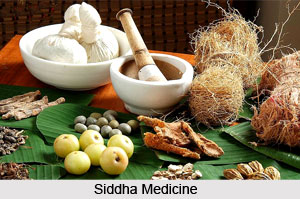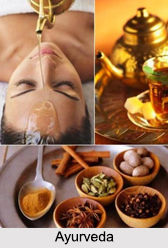 Plants make many chemical compounds that are for biological functions. The use of vegetables or plants and its various parts as medicines is found in the writings of Sushruta. The poisonous root called bish or sringibish is derived chiefly from Aconitum ferox and Aconitum Napellus, which are indigenous to the temperate and sub-alpine Himalaya. Other equally poisonous species of aconite are met with in these regions, and their roots collected for use. Earlier it has been said that of the 9 virulent poisons mentioned by Sanskrit writers, the majority probably consists of species of aconite. The characters of these poisons are described in the Bhabaprakasa, as follows:
Plants make many chemical compounds that are for biological functions. The use of vegetables or plants and its various parts as medicines is found in the writings of Sushruta. The poisonous root called bish or sringibish is derived chiefly from Aconitum ferox and Aconitum Napellus, which are indigenous to the temperate and sub-alpine Himalaya. Other equally poisonous species of aconite are met with in these regions, and their roots collected for use. Earlier it has been said that of the 9 virulent poisons mentioned by Sanskrit writers, the majority probably consists of species of aconite. The characters of these poisons are described in the Bhabaprakasa, as follows:
1. Vatsanabha: This root resembles in appearance as the navel of children, hence it is called Vatsanabha. Its leaves are like those of Vitex Negundo. It is said that no plant can grow near it
2. Haridra: This root resembles turmeric in appearance, hence it is so called.
3. Saktu: This poisonous tuber, when broken, is found to contain a white starch-like substance.
4. Pradipana: This variety is said to be red and shining in appearance, and to cause a severe burning sensation when taken internally,
5. Saurashtrika: This variety of poisonous root is produced in Surat.
6. Sringi: This is a variety of aconite which if tied to the horn of a cow, is said to tinge her milk red.
7. Kalakuta: This poison is said to be the gum of a plant resembling the Ficus religiosa in appearance. It is a native of Malwa.
8. Halahala: The bunches of fruits of this plant resemble those of grapes. Its leaves are like those of the palm tree. It is found in the Himalaya, in the sea coast to the south and in the mountain called Kishkindhya to the north of Mysore.
9. Brahmaputra: This poison is of a tawny colour and causes purging. It grows on the Malayachala, that is, the Western Ghats on the Malabar Coast.
From the above description it would seem that of these 9 poisons, the first 6 are species of aconite. Of these varieties, Vatsanabha has been used in medicine from a very remote period.
Aconite based Plants Used for Fever
Aconite is purified by being cut in small slices and steeped in cow"s urine for 3 days, before being used. It is regarded as heating and stimulant, and useful in diseases supposed to be caused by deranged phlegm and air. It is used in a great variety of affections, but is specially recommended in fever, cephalalgia and affections of the throat, dyspepsia and rheumatism.
 In recent or acute fevers the following is a recommended medicine. "Mrityunjaya Rasa" pills are given with suitable adjuncts in fever supposed to be caused by deranged air, as also in those caused by the derangement of all the humours, that is, in ordinary remittent fever and in that of typhoid type. If there is much constipation along with the fever, croton seeds are added to its ingredients.
In recent or acute fevers the following is a recommended medicine. "Mrityunjaya Rasa" pills are given with suitable adjuncts in fever supposed to be caused by deranged air, as also in those caused by the derangement of all the humours, that is, in ordinary remittent fever and in that of typhoid type. If there is much constipation along with the fever, croton seeds are added to its ingredients.
In fever complicated with cerebral symptoms aconite is used in combination with mercury and datura, as in the following called "Panchavaktra Rasa". Along with these pills a decoction of the root of Calotropis gigantea (arka) with the addition of long pepper, black pepper and ginger is recommended to be taken.
In chronic fever with strong shivering fits, copious perspiration, or much heat of body, aconite is used in combination with salts and aromatics, as in the following called "Saubhagya Vatika".
Aconite is much used in dyspepsia with loss of appetite, in a variety of combinations. The following called "Ramavana Rasa". These pills are given with the addition of powdered black pepper. Another preparation called "Hutasana Rasa" is similar in composition to the above, and is recommended by several writers.
In diseases supposed to be caused by deranged phlegm, such as catarrh, sore throat, cough, asthma, discharges from the ears and nose etc, aconite is used in combination with other heating medicines. The following called "Kapha Ketu Rasa" is a well known medicine for these diseases. A preparation similar to the above and called "Bhairava Rasa" is used in hoarseness and loss of voice.
In boils and other skin diseases aconite is used in the form of liniment and ointment. Visha Taila is a kind of oil, said to be useful in boils, prurigo, psoriasis, leucoderma and other skin diseases.
The tuberous roots of this plant are considered tonic, astringent and stomachic and are used in fever, diarrhoea, irritability of stomach and cough.
Related Articles
Ayurveda
Origin of Ayurveda
Ayurveda Medication
Principles Of Ayurveda
Elements of Ayurveda
Concepts of Ayurveda
Branches of Ayurveda
Ancient Literature of Ayurveda
Asava and Arishta




















